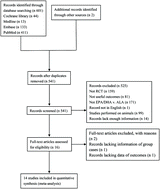当前位置:
X-MOL 学术
›
Food Funct.
›
论文详情
Our official English website, www.x-mol.net, welcomes your feedback! (Note: you will need to create a separate account there.)
Effects of eicosapentaenoic acid and docosahexaenoic acid versus α-linolenic acid supplementation on cardiometabolic risk factors: a meta-analysis of randomized controlled trials
Food & Function ( IF 6.1 ) Pub Date : 2020/03/16 , DOI: 10.1039/c9fo03052b Hengying Chen 1, 2, 3, 4 , Guifang Deng 4, 5, 6, 7 , Quan Zhou 4, 8, 9, 10, 11 , Xinwei Chu 9, 11, 12, 13, 14 , Mengyang Su 9, 11, 12, 13, 14 , Yuanhuan Wei 4, 5, 6, 7 , Liping Li 1, 2, 3, 4 , Zheqing Zhang 9, 11, 12, 13, 14
Food & Function ( IF 6.1 ) Pub Date : 2020/03/16 , DOI: 10.1039/c9fo03052b Hengying Chen 1, 2, 3, 4 , Guifang Deng 4, 5, 6, 7 , Quan Zhou 4, 8, 9, 10, 11 , Xinwei Chu 9, 11, 12, 13, 14 , Mengyang Su 9, 11, 12, 13, 14 , Yuanhuan Wei 4, 5, 6, 7 , Liping Li 1, 2, 3, 4 , Zheqing Zhang 9, 11, 12, 13, 14
Affiliation

|
Previous randomized controlled trials (RCTs) made direct comparisons between EPA/DHA versus ALA on improving cardiovascular risk factors and have reached inconsistent findings. The aim of this meta-analysis was to compare the effects of EPA/DHA vs. ALA supplementation on cardiometabolic disturbances. Databases including MEDLINE, Embase, PubMed and Cochrane Trials were searched until December 2019. The pooled effects (weighted mean difference, WMD) of outcomes with moderate and high heterogeneity were calculated with a random-effects model, while low heterogeneity was calculated with a fixed-effect model. Fourteen RCTs with 1137 participants who met the eligibility criteria were pooled. Compared with participants supplemented with ALA, those who received EPA/DHA supplementation experienced a greater reduction in triglycerides (TG) (WMD −0.191 mmol l−1; 95% CI −0.249, −0.133) but a greater increase in high-density lipoprotein (HDL) (WMD 0.033 mmol l−1; 95% CI 0.004, 0.062), low-density lipoprotein (LDL) (WMD 0.130 mmol l−1; 95% CI 0.006, 0.253) and total cholesterol (TC) (WMD 0.179 mmol l−1; 95% CI 0.006, 0.352). In subgroup analyses, the WMD for TG was much lower in trials with participants >40 years old (−0.246 mmol l−1; 95% CI −0.325, −0.167). When DHA and EPA were separately administered, modest increases in HDL were observed in trials that used DHA as a supplement (0.161 mmol l−1; 95% CI 0.017, 0.304), but not in trials using EPA (0.040 mmol l−1; 95% CI −0.132, 0.212). In conclusion, dietary EPA/DHA supplementation improved the TG and HDL status but increased LDL levels in comparison with ALA.
中文翻译:

二十碳五烯酸和二十二碳六烯酸与α-亚麻酸的补充对心脏代谢危险因素的影响:一项随机对照试验的荟萃分析
先前的随机对照试验(RCT)对EPA / DHA与ALA在改善心血管危险因素方面进行了直接比较,但结果不一致。这项荟萃分析的目的是比较EPA / DHA与EPA / DHA的效果。对心脏代谢紊乱的ALA补充。一直检索到MEDLINE,Embase,PubMed和Cochrane试验的数据库,直到2019年12月。中度和高度异质性结局的合并效应(加权平均差异,WMD)通过随机效应模型计算,低异质性通过固定模型计算效果模型。汇集了符合资格标准的14个RCT,其中有1137名参与者。与补充了ALA的参与者相比,那些接受EPA / DHA补充的参与者的甘油三酸酯(TG)降低更大(WMD -0.191 mmol l -1; 95%CI -0.249,-0.133),但高密度脂蛋白的增加更大(HDL)(WMD 0.033 mmol l -1 ; 95%CI 0.004,0.062),低密度脂蛋白(LDL)(WMD 0.130 mmol l-1 ; 95%CI 0.006,0.253)和总胆固醇(WMD 0.179 mmol l -1 ; 95%CI 0.006,0.352)。在亚组分析中,参与者年龄大于40岁的试验中,TG的WMD低得多(-0.246 mmol l -1; 95%CI -0.325,-0.167)。当分别施用DHA和EPA时,在使用DHA作为补充剂的试验中(0.161 mmol l -1; 95%CI 0.017,0.304)观察到HDL适度增加,但在使用EPA的试验中(0.040 mmol l -1;未观察到HDL适度增加)。 95%CI -0.132,0.212)。总之,与ALA相比,饮食中EPA / DHA的添加改善了TG和HDL的状态,但增加了LDL的水平。
更新日期:2020-03-27
中文翻译:

二十碳五烯酸和二十二碳六烯酸与α-亚麻酸的补充对心脏代谢危险因素的影响:一项随机对照试验的荟萃分析
先前的随机对照试验(RCT)对EPA / DHA与ALA在改善心血管危险因素方面进行了直接比较,但结果不一致。这项荟萃分析的目的是比较EPA / DHA与EPA / DHA的效果。对心脏代谢紊乱的ALA补充。一直检索到MEDLINE,Embase,PubMed和Cochrane试验的数据库,直到2019年12月。中度和高度异质性结局的合并效应(加权平均差异,WMD)通过随机效应模型计算,低异质性通过固定模型计算效果模型。汇集了符合资格标准的14个RCT,其中有1137名参与者。与补充了ALA的参与者相比,那些接受EPA / DHA补充的参与者的甘油三酸酯(TG)降低更大(WMD -0.191 mmol l -1; 95%CI -0.249,-0.133),但高密度脂蛋白的增加更大(HDL)(WMD 0.033 mmol l -1 ; 95%CI 0.004,0.062),低密度脂蛋白(LDL)(WMD 0.130 mmol l-1 ; 95%CI 0.006,0.253)和总胆固醇(WMD 0.179 mmol l -1 ; 95%CI 0.006,0.352)。在亚组分析中,参与者年龄大于40岁的试验中,TG的WMD低得多(-0.246 mmol l -1; 95%CI -0.325,-0.167)。当分别施用DHA和EPA时,在使用DHA作为补充剂的试验中(0.161 mmol l -1; 95%CI 0.017,0.304)观察到HDL适度增加,但在使用EPA的试验中(0.040 mmol l -1;未观察到HDL适度增加)。 95%CI -0.132,0.212)。总之,与ALA相比,饮食中EPA / DHA的添加改善了TG和HDL的状态,但增加了LDL的水平。


























 京公网安备 11010802027423号
京公网安备 11010802027423号